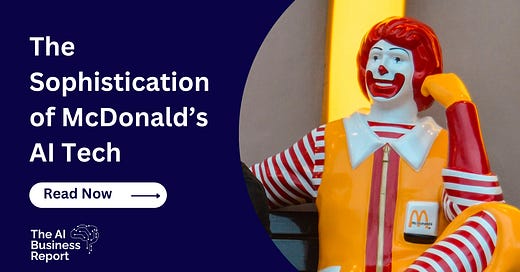The Sophistication of McDonald's AI Technology
How McDonald's Uses AI to Improve their Drive-Thru's
Did you know that McDonald’s makes over $75 million per day? This astonishing number is not just thanks to McDonald’s being the world's favorite casual eatery, but their adoption of innovative technology, including artificial intelligence.
Snafus remedied, McDonald's continues to use AI technology today. Keep reading to learn more about McDonald's history of technological innovation and how the company uses AI to enhance its operations.
McDonald’s History of Technology and Innovation
Despite not being the first company to implement a drive-thru ordering system, a title claimed by In-N-Out Burger in 1948, McDonald’s has refined the service to create a smooth and efficient customer experience.
McDonald’s drive-thrus all feature digital screens that update based on menu changes and current offers and allow customers to order through a microphone before reaching the first window. In some instances, that voice you might hear speaking back doesn't even work for McDonald's.
In 2004, a McDonald's franchisee in Missouri had the ingenious idea of outsourcing his drive-thru operators to call center workers in another state. Doing so allowed the restaurant owner to increase customer traffic by 30 additional cars per hour, generating more sales and inspiring other fast-food chains like Jack in the Box to do the same.
Now, in a post-COVID era, McDonald’s is aiming to push the boundaries of efficiency even further, with the implementation of AI (discussed in the following section), as well as a loyalty reward scheme called MyMcDonald’s.
McDonald’s Attempts at AI-Integration
In 2019, McDonald's acquired two innovative tech firms for a significant price tag: Apprente, which specializes in voice technology, and Dynamic Yield, which specializes in decision logic technology. Dynamic Yield alone cost over $300 million.
The acquisition of these entities led to the creation of McD Tech Labs. In other words, since 2019, McDonald’s has become a tech company.
Yet, despite the innovative power McDonald’s order prediction technology offered, the company decided to sell Dynamic Yield to Mastercard and Apprente to IBM. However, this came as part of an agreement with Mastercard and IBM to help each other accelerate their AI capabilities.
So, how exactly has McDonald’s implemented AI into their business?
Automated Drive-Thrus
The premise of McDonald’s automated drive-thrus is no more complicated than using Siri on your phone or other voice assistants. Crucially to McDonald’s, however, the Apprente voice technology can filter out loud background noise to accurately understand orders.
Using the voice technology acquired through Apprente, McDonald’s offers customers efficient drive-thru service with their orders taken and processed by a voice assistant. This reduces the margin of human error and speeds up ordering time, creating a smoother customer experience.
Order Prediction
Using Dynamic Yield’s machine learning technology, McDonald’s can record customer license plate numbers, cross reference them with their orders, and build a customer profile. Then, when the customer returns, McDonald’s can upsell products they know the individual likes. For example, if a customer repeatedly buys strawberry milkshakes, the ML algorithm will display them more prominently on their digital screens than other products.
The Dynamic Yield machine learning technology goes beyond order history. It can also predict which products will sell well based on weather, time of day, existing order selections, restaurant traffic, and item popularity. Since integrating this technology with their digital drive-thru screens, McDonald’s has increased their sales by up to 3.5 percent in Canada.
Meanwhile, in Japan, customers who use the McDonald’s mobile app, which also recommends products based on an ML algorithm, spend an average of 35 percent more than others.
An Innovative Use of AI
McDonald’s use of artificial intelligence ultimately highlights the innovative use of AI in real-life business operations, removed from simple applications such as VA work or text generation. It’s an excellent example of a significant company leading the way in industry innovation and adopting new technologies.



